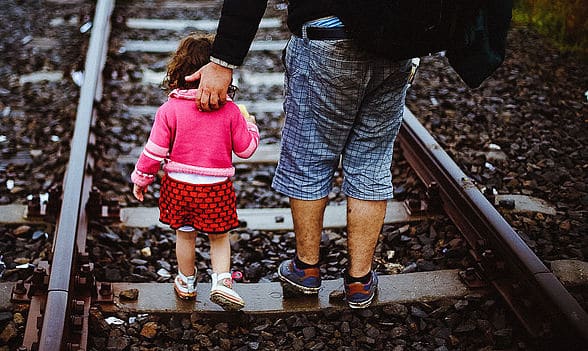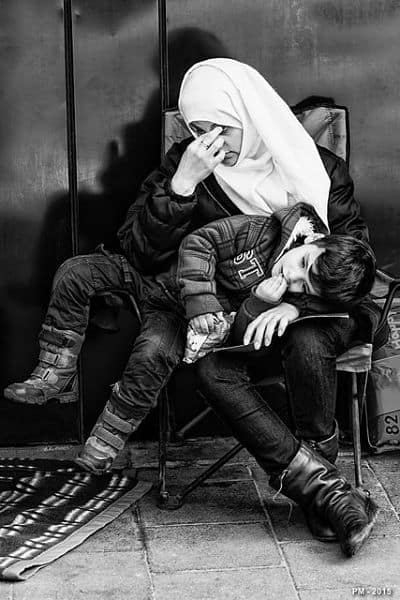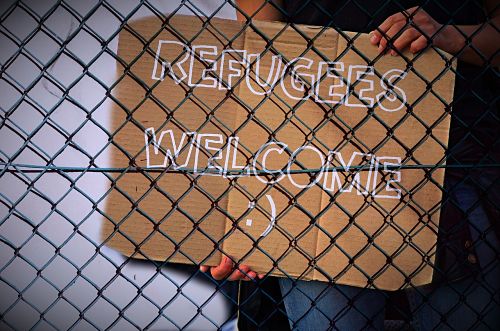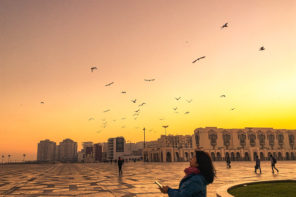Writing ethnography in sites and times of “crisis” is a challenge that more and more anthropologists are dealing with, as this historical moment is punctuated with multiple crisis discourses and hot spots. Of course, this proliferation of crises is by no means an accident; as others have shown quite convincingly, “crisis” is a cosmology perhaps endemic to neoliberal worlds (Lapavitsas 2014; Lapavitsas and Kouvélakis 2012; Redfield 2005, 2013; Roitman 2014). As I was writing my book , I persistently encountered the challenges of writing a “history of the present” (Foucault 1977) that was—and still is—powerfully in a process of unfolding, without any predictable end or telos. At such moments, it is easy to forget that change is always happening, even in times of apparent calm or stasis.
Crises are periods when time seems to speed up, and when the present simultaneously acquires an added dimension and density—thick with the ethos of heated struggle and rapid change.

Even critical accounts of crisis, however, frequently neglect the continuities that permeate moments of rapid change, and the often entrenched practices and socio-political forms that underlie them. Crisis has a kind of maghia, a bewitching quality, not just for wider publics but also for researchers: it can pull us in (see even Cultural Anthropology’s wonderful “Hot Spots” section); it makes certain topics and places dangerous and sexy when they weren’t before (Greece, anyone?), and promotes the urgent need to be on the apparent “frontlines” of whatever is coming next. Journalists, of course, often live on crises.
But this spell, this maghia, is dangerous: Crisis-thinking distracts us (see Rakopoulos 2014). Crisis-thinking encourages us to approach such moments as aberrations, exceptions to the normality of social and political orders (see Agamben 2005; Athanasiou 2012). Continuities, however, usually are palpably evident in hindsight: for instance, looking back on Hurricane Katrina ten years later, from the viewpoint of the U.S., it is hard not to see the deep forms of class-based and racialized injustice that shaped the outcomes of this “natural” event. It is easy to forget, however, the many who had the foresight to present crucial critiques of these injustices when that particular crisis was unfolding (and who are likely saying now—without any sense of satisfaction—“I told you so.”)
Crisis-thinking is also dangerous for how it reifies power relationships and active decisions that lie behind political and economic realities, and for how it presents certain injustices as given and unavoidable when—perhaps—things really could be different.
For this reason, for instance, many of my colleagues working in Greece are careful to talk about “Greece under austerity” as opposed to “crisis Greece,” since economic and financial instabilities (read as “crisis”) are deeply tied to the eleven (yes, eleven !) technocratic and deeply politicized austerity packages that Greece has been made to adopt since 2010. Austerity is a concept that recognizes a political reality—a set of humanly crafted and imposed policies and practices—whereas crisis invokes the mystical authority of the “market” and the (ironically) deeply non-rationalist neoliberal logic that “there is no alternative.” The language surrounding the “migrant” or “refugee crisis” does similar work: it strips European decision makers of responsibility for a political and human context that has been, I would argue, in-the-making for years.
Having done research on asylum in Greece since 2005—with advocates and activists who have been working in the field of asylum since the nineties or even eighties—it is difficult to see this “crisis” as entirely new. Instead, it appears as the intensification of predicaments that previously were restricted to certain sites (such as border areas, detention centers, the living quarters of migrants and refugees, even the office where I conducted my fieldwork), where the ethos of crisis and emergency was so dominant that it often became banal (Hage 2009). But these sites were largely invisible to larger publics; instead, they were “Twilight Zones,” in the words of one of my interlocutors. Of course, crucial aspects of the current reality are new: there is a civil war in Syria, and there are unprecedented numbers of people coming to Europe right now seeking refuge. But these persons have also become visible in a new way—in spaces and to audiences that previously remained largely in the dark.

Photo by Freedom House (flickr, Public Domain)
There are two central continuities of this present predicament that my book underscores. I want to note that my book was written and published before the current moment of crisis (and the majority of the fieldwork was carried out before massive political upheaval in Syria). There have been real changes in place in Greece, Europe, and the wider Mediterranean world. But I hope that the following two points will strike readers as relevant and will highlight the equally real forms of decision-making and structural violence that are longstanding, and perhaps even endemic, to both Europeanization and asylum politics more broadly. These interventions concern: 1) the European politics of marginality and exclusion, and 2) the fundamental insufficiency and even violence of asylum regimes.
The very first chapter of my book refers to the inequities that have shaped European migration and asylum law and policy, which for years have conspired successfully to outsource the “problem” of migration to the borders.[1] This is a fact. The Dublin Regulation (Dublin II 2003, Dublin III 2013) is an EU law that demands that people file for asylum and remain in the country where they first enter Europe. This law was initially articulated as a way to encourage “responsibility-” or “burden-” sharing among European member states. But given that most people enter Europe via the borders, it has long had the material effect—since even before 2005, when I began my fieldwork—of making border countries the “prison of Europe,” as one interlocutor (an Iranian refugee) explained it to me. My book is rife with stories of people in the asylum system struggling to survive while “stuck” in Greece, as well as the accounts of people who were caught in the Dublin system, shuttling back and forth between Greece and other places in the North where they worked, had families, or even made their homes. Given the obvious inequities as well as material humanitarian concerns generated through Dublin, European advocates and activists have been working for years to challenge the Dublin system, with significant but still only partial effects.
Additionally, Greece—like other external border countries—has been tasked with maintaining the “security” and “humanitarianism” of Europe. I hope that the tensions entailed in such a project are obvious.
Border countries—many lacking adequate capacities and support for either of these tasks—have provided very useful scapegoats in the power arenas of the European Union.
As legal scholar Leti Volpp commented when discussing one of my in-process chapters in 2011, “Greece is a little bit like the Arizona of Europe.” Greece (like Hungary these days perhaps?) has, for awhile now, been a very convenient place to concentrate the blame regarding the poor management of migration and asylum in Europe, while partially absolving the Powers-That-Be in Europe of bad behavior.
External EU border fences—which have recently (and rightly) been the topics of large-scale critiques—are an interesting example of how European migration management outsources the “dirty work” to the borders. For instance, we hear again and again that Hungary is building a fence, accompanied with references to Fascist undercurrents permeating their current government and the populace at large. But we rarely hear discussions about why Hungary is building a fence; the assumption seems to be that Hungarians simply do not want people entering via their borders. Now, this may or may not be the case. But it is also important to recognize that fences are one way in which border countries have demonstrated their readiness to comply with their EU obligations in securing and managing their borders. Greece initiated its own border fence along the land border in the North in 2011, after it was determined that around 90 percent of those entering Europe did so through the Evros border. This fence was inaugurated under the Papandreou government (somewhat more open on questions of migration), and it was completed under Antonis Samaras (a prime minister with clear anti-immigration sentiments). Even as the European Commission questioned the utility of the fence, EU bodies provided Greece with advanced surveillance technology and border patrol personnel in the form of RABITS (Rapid Response Border Intervention Teams).[2] Fences are built in part so that marginal member countries (their own Europeanness often in question) can meet their obligations as good member states in securing the borders of Europe.
These EU efforts toward securitization (Feldman 2011) have redirected crossings back to the Aegean and introduced a new route through Balkan countries. Just to clarify: People are moving through the Balkans not because it is the shortest and safest route to other parts of Europe, but because other borders have been closed down through policing (such as the sea border between Greece and Italy—which is also dangerous, where people used to smuggle themselves into the cargo containers of trucks on ferry boats). After an unprecedented number of deaths in the Aegean in Fall 2015, people have begun mobilizing to encourage the Greek government to create holes in the fence. The Syriza government has replied that this is not possible for “technical reasons.”
Attention to the inequities of European migration management in no way excuses the also very real, deeply problematic decision making in border countries. But I want to underscore the systematic ways in which this “crisis” has, in part, been produced through macro-European programs and policies on migration. The numbers of people seeking to enter Europe have certainly grown enormously. But the border game that seems to have emerged during the current crisis is not just a result of “migrant flows” but also of European border politics.
Policing and securitization have materially shaped the ways in which people move, rendering their movements illegitimate, illegal, and dangerous.
Thanks to scapegoats on the borders, certain European leaders and member states can then lay claim to humanitarian outlooks: Hungary becomes the new pariah, while Germany comes out smelling like a rose.[3]
My second point here entails perhaps the central theme of my book: the ways in which asylum systems denote certain lives as “worthy” of protection, while others are framed as less valuable or, quite simply, as not worth saving. Certain deaths are mourned while others are not even acknowledged. The central binary shaping this endemic violence of asylum politics is, not surprisingly, the dyad of refugee/migrant:
the “refugee” is assumed to be the one in need, who has been made to flee, whose presence is (in part) legitimate; whereas the “migrant” is characterized as having chosen to come “for work” and who also perhaps “abuses” the asylum system. The “refugee” can’t go home, whereas the “migrant” must.[4]
In my book, I detail the hard work that asylum seekers, bureaucrats, and advocates undertake in order to create this illusion of categorical purity (Malkki 1995). This dyad is a founding distinction on which the system is based, but in practice things most often fall apart. Categories are muddy, cases are rarely clear, and decision-making is often agonizing, with indeterminate effects. Sometimes, aspects of justice are achieved but only partially—and most often at the interstices of formal law and everyday lived practice. I show that the “real refugee” (like the “real” migrant) is elusive and even illusory—and human rights professionals most often recognize this dilemma. Asylum adjudicators and lawyers know better than most that “political” violence is very difficult to separate from “economic” violence, and that questions of truth and credibility are rarely resolved satisfactorily. And so asylum systems function through confabulations and deep uncertainties, yet they are always refracted through the assumed clarity of the refugee/migrant distinction.

Syrian refugees, Brussels (photo by Patrick Marioné, flickr, CC BY-NC-ND 2.0)
But one rather extraordinary aspect of this present crisis is that the world, en masse, seems to have encountered an idealized figuration of the “real refugee”—the life worthy of protecting, and the death worthy of grieving (Butler 2004)—in the figure of the Syrian Refugee. I use the term figure intentionally: people from Syria are, like people everywhere, diverse, complex, and can never be distilled into one set of categories or tropes. And yet media discourses and political messages have consolidated this diversity of persons into powerful stereotypes of vulnerability, victimhood, race, and class, which render Syrians into an undifferentiated whole now legible in terms associated with “refugee-ness.” What is lost in this consolidation are the layers and complexities of personhood and life trajectories, yet there are certain uses to such simplified tropes: humanitarian and human rights interventions in Europe (and elsewhere) currently center almost entirely on Syrians—with perhaps a few Afghans and Iraqis thrown in for good measure.
Syrians coming to Europe are, of course, fleeing profound dangers. But Afghans, Iraqis, and many others are also fleeing–and have been doing so for years. They have been living in Europe, crafting meaningful lives in spite of it all. They have also been suffering (not just en route but within Europe), and they too have been dying: in the Aegean, in Evros, and even in the hearts of European cities and towns. The question, then, is why do people care now when they didn’t care then? This is a topic for a longer piece, and indeed, I am working on it. In the meantime, Jan Blommaert has written a wonderful blog post analyzing the role of three particular images in making Europe “care about refugees:” the first image, the Ethiopian woman saved by the burly Greek fisherman in the Aegean; the second, the Syrian man weeping with his family in his arms; and the last, the body of the toddler on the Turkish beach, his chubby legs and hands so perfect he could almost still be alive.
These lives—and deaths—matter. But I think we also need to be asking the following questions:
Why do we need pictures of women, families, and dead children to “care?” And why have the lives and deaths of people who have been fleeing toward Europe for years (often young Muslim men) largely gone unnoticed?
In closing, I want to offer a few observations about what might make the current refugee crisis so compelling for Europe and the Global North/West.
Syrian lives matter. But international politics also matter: Syrians are fleeing the ultimate evil empire of Islamic terrorism. Iraqis and Afghans are fleeing wars perpetrated by NATO and (primarily of course) the U.S.
Class matters: Syrians are frequently lauded for their education level, their savvy use of social media, and the many ways in which they are “just like us.” How often have we heard that Steve Jobs was of Syrian descent? On the radio the other day, a journalist made the following comment regarding a Syrian man he had met: “this guy had a university degree”— adding that this man did not seem like the “kind of person” to be sleeping in a makeshift camp. So who does seem like “the kind of person” to be sleeping in a makeshift camp?
Race matters: Syrians are framed as “whiter,” culturally and even phenotypically, than Afghans and Iraqis – more cosmopolitan, somehow “closer” to the heart of West. After all, there are even Christians among them! (Perhaps it is relevant that Chaldean Christians from Iraq have regularly received asylum over the years.)
Notions of vulnerability and victimhood matter: Syrian families—and children—have been the subjects of profoundly disturbing images of suffering and death. These images are horrific. We cannot put words to their horror. But again, why are these lives worth saving (and mourning) while others go unnoticed?
While a part of me is glad that there may be a new culture of “caring” in the reception of people coming into Europe, I am deeply worried about the kinds of systems and decisions on which this caring is based.
Like the “migrant crisis” itself, these responses to the crisis neglect—again—to ask critical questions, and thus run the risk of perpetuating these very forms of violence: politicized and intentional maneuverings in the deeply unequal EU; violent and exclusionary European border policies and practices; and the violence at the heart of asylum itself. These are just some of the continuities that undergird the current crisis.
Works Cited
Agamben, Giorgio. 1998. Homo Sacer: Sovereign Power and Bare Life. Heller-Roazen, David Stanford: Stanford University Press.
Athanasiou, Athina. 2012. Η Κρίση Ως Κατάσταση “Έκτακτης Ανάγκης” [the Crisis as State of Emergency”]. Athens: Savvalas.
Butler, Judith. 2004. Precarious Life: The Powers of Mourning and Violence. London: Verso.
Foucault, Michel. 1977. Discipline and Punish: The Birth of the Prison. New York: Pantheon.
Geertz, Clifford. 1975. The Interpretation of Cultures : Selected Essays. London: Hutchinson.
Gluckman, Max. 2006 [1965]). Politics, Law, and Ritual in Tribal Society. New Brunswick, United States; London, United Kingdom: Aldine Transaction
Gramsci, Antonio. 1992. Prison Notebooks. European Perspectives New York: Columbia University Press.
Hage, Ghassan. 2009. “Waiting out the Crisis: On Stuckedness and Governmentality.” In Waiting, Hage, Ghassan. Carleton, Victoria: Melbourne University Press.
Herzfeld, Michael. 2002. “The Absent Presence: Discourses of Crypto-Colonialism.” The South Atlantic Quarterly 101:900-926.
Lapavitsas, Costas. 2014. Λέξη προς Λέξη : Κείμενα για την Ελληνική Κρίση, 2010-2013. Athēna: Ekdoseis Topos.
Lapavitsas, Costas, and Eustache KouvéLakis. 2012. Crisis in the Eurozone. London ; New York: Verso.
Malkki, Liisa. 1995. Purity and Exile: Violence and National Cosmology among Hutu Refugees in Tanzania. Chicago and London: University of Chicago Press.
Rakopoulos, Theodoros. 2014. “The Crisis Seen from Below, within, and Against: From Solidarity Economy to Food Distribution Cooperatives in Greece.” Dialectical Anthropology 38:189-207.
Redfield, Peter. 2005. “Doctors, Borders and Life in Crisis.” Cultural Anthropology 20:328-361.
___. 2013. Life in Crisis : The Ethical Journey of Doctors without Borders. Berkeley: University of California Press.
Roitman, Janet L. 2014. Anti-Crisis. Durham: Duke University Press.
Turner, Victor W. 1967. The Forest of Symbols; Aspects of Ndembu Ritual. Ithaca, N.Y.,: Cornell University Press.
___. 1974. Dramas, Fields, and Metaphors; Symbolic Action in Human Society. Symbol, Myth, and Ritual Ithaca [N.Y.]: Cornell University Press.
Footnotes
[1] Michael Herzfeld’s (2002) concept of crypto-colonialism has been, in many ways, prophetic in relation to the current crises, highlighting how Greece’s position vis-à-vis the power players of the west is always deeply unequal but this asymmetry is often hidden (thus making it even more difficult to contest).
[3] See here and here for some less laudatory accounts of Germany’s position.
[4] I should note that there are high stakes in this distinction that advocates and human rights professionals protect staunchly. The framework of “asylum” (while deeply imperfect) does provide certain crucial protections, but without a comprehensive system for addressing the diversity of migratory forms at work in Europe, asylum often becomes an instrument of exclusion. Moves toward using the term “refugee” over “migrant” in larger media discourses are well-intended but actually perpetuate the mirror image of this exclusion: as if it’s somehow OK for “migrants” to die in the Aegean. We do not yet have language to address these complexities. This topic deserves more than a footnote.
[5] Also worthy of larger discussion is the fact that in many cases the legal statuses being granted to Syrians are temporary, based largely on forms of subsidiary or humanitarian protection, as opposed to the long-term form of protection granted through refugee Status.
Read an interview with Heath Cabot on her book On the Doorstep of Europe here.
Read a review of Heath Cabot’s book here.










